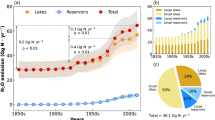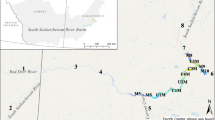Abstract
Human activities have greatly increased the transport of biologically available nitrogen (N) through watersheds to potentially sensitive coastal ecosystems. Lentic water bodies (lakes and reservoirs) have the potential to act as important sinks for this reactive N as it is transported across the landscape because they offer ideal conditions for N burial in sediments or permanent loss via denitrification. However, the patterns and controls on lentic N removal have not been explored in great detail at large regional to global scales. In this paper we describe, evaluate, and apply a new, spatially explicit, annual-scale, global model of lentic N removal called NiRReLa (Nitrogen Retention in Reservoirs and Lakes). The NiRReLa model incorporates small lakes and reservoirs than have been included in previous global analyses, and also allows for separate treatment and analysis of reservoirs and natural lakes. Model runs for the mid-1990s indicate that lentic systems are indeed important sinks for N and are conservatively estimated to remove 19.7 Tg N year−1 from watersheds globally. Small lakes (<50 km2) were critical in the analysis, retaining almost half (9.3 Tg N year−1) of the global total. In model runs, capacity of lakes and reservoirs to remove watershed N varied substantially at the half-degree scale (0–100%) both as a function of climate and the density of lentic systems. Although reservoirs occupy just 6% of the global lentic surface area, we estimate they retain ~33% of the total N removed by lentic systems, due to a combination of higher drainage ratios (catchment surface area:lake or reservoir surface area), higher apparent settling velocities for N, and greater average N loading rates in reservoirs than in lakes. Finally, a sensitivity analysis of NiRReLa suggests that, on-average, N removal within lentic systems will respond more strongly to changes in land use and N loading than to changes in climate at the global scale.


Similar content being viewed by others
References
Ahlgren I, Sorenssson F et al (1994) Nitrogen budgets in relation to microbial transformations in lakes. Ambio 23(6):367–377
Alexander RB, Smith RA et al (2000) Effect of stream channel size on the delivery of nitrogen to the Gulf of Mexico. Nature 403(17):758–761
Alexander RB, Elliott AH et al (2002) Estimating the sources and transport of nutrients in the Waikato River Basin, New Zealand. Water Resour Res 38(12):1268. doi:10.1029/2001WR00878
Alexander RB, Böhlke JK et al (2008) Dynamic modeling of nitrogen losses in river networks unravels the coupled effects of hydrological and biogeochemical processes. Biogeochemistry. doi:10.1007/s10533-008-9274-8
Andersen HVJM (1974) Nitrogen and phosphorus budgets and the role of sediments in six shallow Danish lakes. Arch Hydrobiol 74(4):528–550
Ayers JC (1970) Lake Michigan environmental survey. Great Lakes Research Division Special Report 49. University of Michigan, Ann Arbor
Bouwman AF, Van Drecht G et al (2005) Exploring changes in river nitrogen export the world’s oceans. Global Biogeochem Cycles 19:GB1002. doi:10.1029/2004GB002314
Brahney J, Bos DG et al (2006) The influence of nitrogen limitation on delta N-15 and carbon:nitrogen ratios in sediments from sockeye salmon nursery lakes in British Columbia, Canada. Limnol Oceanogr 51(5):2333–2340
Calderoni A, Mosello R, Tartari G (1978) Hydrochemistry and chemical budget or Lago Mergozzo (Northern Italy). Memorie dell’Istituto Italiano di Idrobiologia 36:239–269
Carpenter SR, Caraco NF et al (1998) Nonpoint pollution of surface waters with phosphorus and nitrogen. Ecol Appl 8(3):559–568
Cole JJ, Prairie YT et al (2007) Plumbing the global carbon cycle: integrating inland waters into the terrestrial carbon budget. Ecosystems 10(1):171–184
Dillon PJ, Molot LA (1990) The role of ammonium and nitrate retention in the acidification of lakes and forested catchments. Biogeochemistry 11(1):23–43
Downing JA, Prairie YT et al (2006) The global abundance and size distribution of lakes, ponds, and impoundments. Limnol Oceanogr 51(5):2388–2397
Dudel G, Kohl JG (1992) The nitrogen budget of a shallow lake (Grosser Muggelsee, Berlin). Int Rev Gesamten Hydrobiol 77:43–72
Dumont E, Harrison JA et al (2005) Global distribution and sources of DIN export to the coastal zone: results from a spatially explicit, global model (NEWS-DIN). Global Biogeochem Cycles 19, GB4S02:1–14. doi:10.1029/2005GB002488 GB4S02
Fekete BM, Vorosmarty CJ et al (1999) Global, composite runoff fields based on observed river discharge and simulated water balances; Report Number 22 (2nd edn.), Global Runoff Data Center. Federal Institute of Hydrology, Koblenz
Galloway JN, Aber JD et al (2003) The nitrogen cascade. Bioscience 53:341–356
Galloway JN, Dentener FJ et al (2004) Nitrogen cycles: past, present and future. Biogeochemistry 70:153–226
Garnier J, LePorcq B et al (1999) Biogeochemical mass-balances (C, N, P, Si) in three large reservoirs of the Seine Basin (France). Biogeochemistry 47:119–146
Green PA, Vorosmarty CJ et al (2004) Pre-industrial and contemporary fluxes of nitrogen through rivers: a global assessment based on typology. Biogeochemistry 68(1):71–105
Howarth RW et al (1996) Regional nitrogen budgets and riverine N and P fluxes for the drainages to the North Atlantic Ocean: natural and human influences. Biogeochemistry 35(1):75–139
Jensen JP, Kristensen P, Jeppesen E (1990) Relationships between nitrogen loading and in-lake concentrations in shallow Danish lakes. Verh Internat Verein Limnol 24:201–204
Jensen JP, Jeppesen E, Kristensen P, Christensen PB, Søndergaard M (1992) Nitrogen loss and denitrification as studied in relation to reductions in nitrogen loading in a shallow, hypertrophic lake (Lake Søbygård, Denmark). Int Rev Gesamten Hydrobiol 77:29–42
Jeppesen E, Jensen JP et al (1998) Changes in nitrogen retention in shallow eutrophic lakes following a decline in density of cyprinids. Arch Hydrobiol 142(2):129–151
Kelly VJ (2001) Influence of reservoirs on solute transport: a regional-scale approach. Hydrol Process 15:1227–1249
Kelly CA, Rudd JWM et al (1987) Prediction of biological acid neutralization in acid-sensitive lakes. Biogeochemistry 3(1/3):129–140
Kelly CA, Rudd JWM et al (1997) Increases in fluxes of greenhouse gases and methyl mercury following flooding of an experimental reservoir. Environ Sci Technol 31:1334–1344
Leavitt PR, Brock CS, Ebel C, Patoine A (2006) Landscape-scale effects of urban nitrogen on a chain of freshwater lakes in central North America. Limnol Oceanogr 51:2262–2277
Lehner B, Döll P (2004) Development and validation of a global database of lakes, reservoirs and wetlands. J Hydrol 296(1–4):1–22
Lewis WM Jr (1983) A revised classification of lakes based on mixing. Can J Fish Aquat Sci 40:1779–1787
Mengis M, Gachter R et al (1997) Nitrogen elimination in two deep eutrophic lakes. Limnol Oceanogr 42(7):1530–1543
Molot LA, Dillon PJ (1993) Nitrogen mass balances and denitrification rates in central Ontario Lakes. Biogeochemistry 20(3):195–212
Mulholland PJ, Helton AM et al (2008) Stream denitrification across biomes and its response to anthropogenic nitrate loading. Nature 452(7184):202–205
Nõges P (2005) Water and nutrient mass balance of the partly meromictic temperate Lake Verevi. Hydrobiologia 547:21–31. doi:10.1007/s10750-005-4140-3
Nõges P, Järvet A, Tuvikene L, Nõges T (1998) The budgets of nitrogen and phosphorus in shallow eutrophic Lake Võrtjärv. Hydrobiologia 363:219–227
Patoine A, Graham MD, Leavitt PR (2006) Spatial variation of nitrogen fixation in lakes of the northern Great Plains. Limnol Oceanogr 51:1665–1677
Peterson BJ, Wollheim W et al (2001) Control of nitrogen export from watersheds by headwater streams. Science 292:86–90
Piña-Ochoa E, Álvarez-Cobelas M (2006) Denitrification in aquatic environments: a cross-system analysis. Biogeochemistry 81:111–130
Salas HJ, Martino P (1991) A simplified phosphorus trophic state model for warm-water tropical lakes. Water Res 25(3):341–350
Saunders DL, Kalff J (2001) Nitrogen retention in wetlands, lakes and reservoirs. Hydrobiologia 443:205–212
Seitzinger SP, Harrison JA (2008) Sources and delivery of nitrogen to coastal systems, Chap. 8. In: Capone D, Bronk DA, Mullholland MR, Carpenter E (eds) Nitrogen in the marine environment, 2nd edn. Academic Press, New York
Seitzinger SP, Kroeze C (1998) Global distribution of nitrous oxide production and N inputs in freshwater and coastal marine ecosystems. Global Biogeochem Cycles 12(1):93–113
Seitzinger SP, Styles RV et al (2002) Nitrogen retention in rivers: model development and application to watersheds in the northeastern USA. Biogeochemistry 57:199–237
Seitzinger SP, Harrison JA et al (2006) Denitrification across landscapes and waterscapes: a synthesis. Ecol Appl 16(6):2064–2090
Takeuchi K (1997) Least marginal environmental impact rule for reservoir development. Hydrol Sci 42(4):583–597
Teodoru C, Wehrli B (2005) Retention of sediments and nutrients in the Iron Gate I Reservoir on the Danube River. Biogeochemistry 76(3):539–565
Tomaszek JA, Koszelnik P (2003) A simple model of nitrogen retention in reservoirs. Hydrobiologia 504:51–58
Vitousek PM, Aber JD et al (1997) Human alteration of the global nitrogen cycle: sources and consequences. Ecol Appl 7(3):737–750
Wetzel RG (2001) Limnology. Lake and river ecosystems, 3rd edn. Academic Press, San Diego. xvi, 1006 pp
Windolf J, Jeppesen E et al (1996) Modelling of seasonal variation in nitrogen retention and in-lake concentration: A four-year mass balance study in 16 shallow Danish lakes. Biogeochemistry 33(1):25–44
Wollheim WM, Vörösmarty CJ et al (2006) Relationship between river size and nutrient removal. Geophys Res Lett 33(6). doi:10.102912006GL025845
Wollheim WM, Vörösmarty CJ et al (2008) Global N removal by freshwater aquatic systems: a spatially distributed, within-basin approach. Global Biogeochem Cycles GB2026. doi:10.11029/2007GB002936
Acknowledgments
We would like to thank Jeff Cornwell and P. Mulholland for valuable input at early stages of this paper’s development. This paper is a product of a workshop on Denitrification Modeling Across Terrestrial, Freshwater, and Marine Systems, held November 28–30, 2006, at the Institute of Ecosystem Studies, Millbrook, NY, with support from the Denitrification Research Coordination Network of the National Science Foundation, award DEB0443439 and the Northeastern States Research Cooperative (Grant # 02-CA-11242343-105). This research was also supported by grants to J.A. Harrison from the U.S. Geological Survey 104b program and R. Maranger (FQRNT Strategic Professor) and by the USGS National Water Quality Assessment Program.
Author information
Authors and Affiliations
Corresponding author
Rights and permissions
About this article
Cite this article
Harrison, J.A., Maranger, R.J., Alexander, R.B. et al. The regional and global significance of nitrogen removal in lakes and reservoirs. Biogeochemistry 93, 143–157 (2009). https://doi.org/10.1007/s10533-008-9272-x
Received:
Revised:
Accepted:
Published:
Issue Date:
DOI: https://doi.org/10.1007/s10533-008-9272-x




